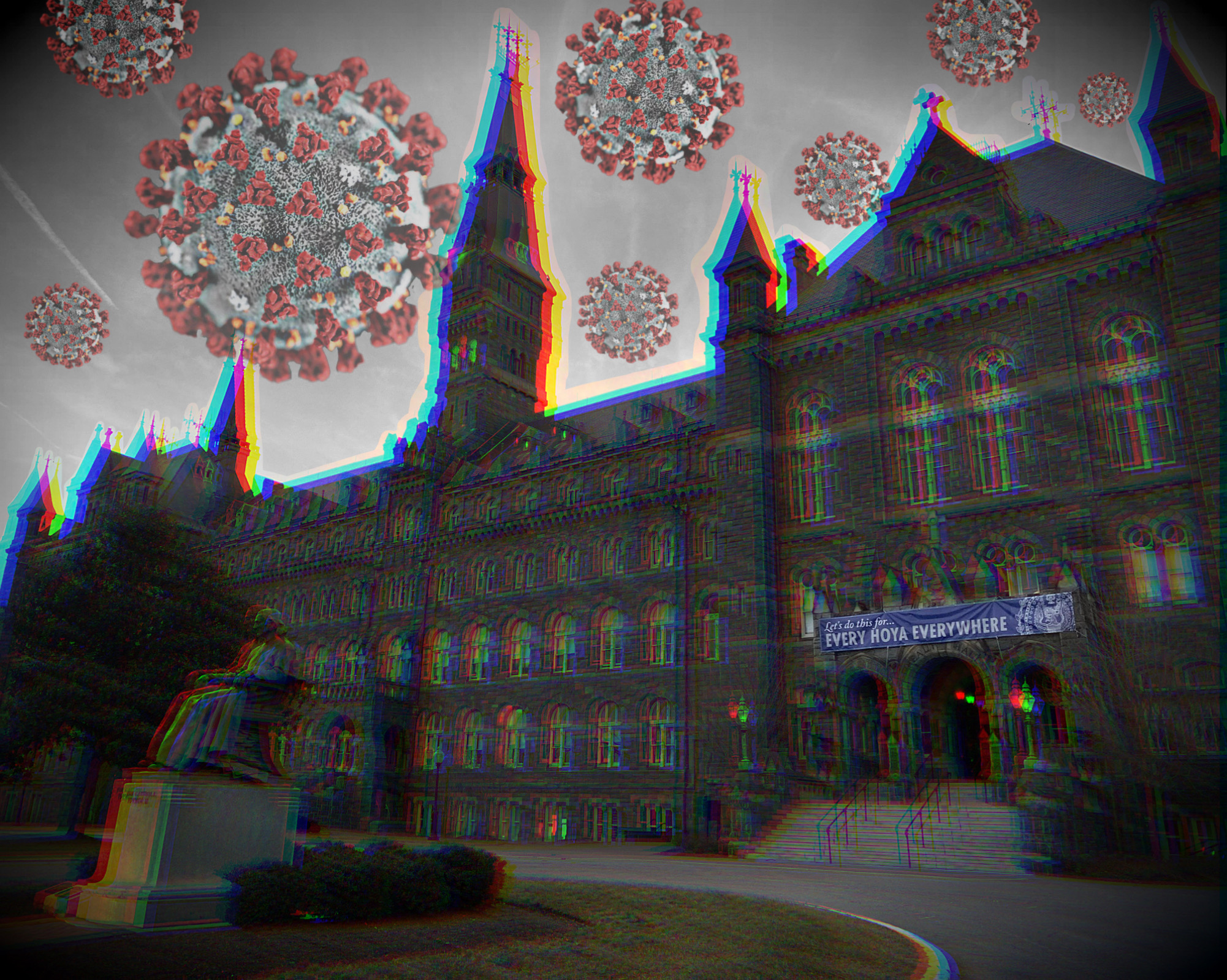The first few weeks of the spring semester have been marked by a significant uptick in COVID-19 cases, coinciding with many Georgetown students’ return to the area for the spring semester. The surge, a stark reminder of the university’s ongoing challenges in reopening, comes almost a full year after students were initially sent home from campus as the pandemic began its spread across the country.
Of the 279 positive cases confirmed by the university since Jan. 3, 180 of those cases—over 50 percent—are from students living off campus in the Georgetown, Burleith, and Foxhall neighborhoods. Student concerns over cases grew on Feb. 1, after the university announced that 109 positive cases were reported to the university in the week of Jan. 24. Eight cases were on-campus residents, 13 were employees on the main and medical campuses, two were on the law campus, and 86 were from the three nearby neighborhoods. These numbers do not account for the positivity rates of students living in Virginia, Maryland, and other D.C. neighborhoods like Foggy Bottom.
The high positivity rate is worrying students like Sarah Pino (NHS ’24), one of approximately 1,000 on-campus residents. For many students, university housing is crucial due to health concerns or instability at home. “I have three immunocompromised people at home, and I don’t want to kill them because somebody went to a party and didn’t tell me and I hung out with them,” she said, expressing concern that the increase in interpersonal gatherings would cause students on campus to lose housing. “Students who live on campus, specifically students who are here not because they are international students or not because they’re student athletes, are more in fear than anybody else in housing.”
The university’s reopening plan welcomed back a select group of students to live in university housing for the spring, including seniors, qualifying international students, and others in need of housing. This is nearly twice the number from the fall semester, when approximately 500 students were invited back to campus via the Housing Stability Application due to high financial need, housing instability, health concerns, or significant time zone differences. In addition to on-campus residents, many Hoyas also moved to adjacent neighborhoods in the DMV area to be near campus during the COVID-19 shutdown.
It’s the numbers in those neighborhoods that Milan Perry (COL ’21), a campus resident living in Ida Ryan and Isaac Hawkins Hall, is concerned about. “I think the numbers show that some off-campus students are spreading COVID amongst themselves, so there’s room for improvement there,” she said. “I’m glad that Georgetown has temporarily revoked off-campus students’ access to campus considering the higher number of cases off-campus.”
While seniors, including those living off-campus, were initially offered hybrid courses to attend in person, the local outbreak forced the university to halt in-person meetings until March 8. Other measures taken by the university to limit transmission include pausing in-person office-based research, ceasing on-campus religious and recreational activities, restricting Lauinger Library services, and reminding students to avoid indoor social gatherings. The university is working with epidemiologists from the D.C. Department of Health to understand what drove the sudden increase.
Those who have been vocal about their frustrations with the rise in case numbers are pointing to student noncompliance with COVID-19 guidelines as a potential cause of cases. “The on-campus atmosphere right now is pretty toxic. Everyone is blaming certain groups (off campus students, athletes, etc.) instead of paying attention to their own behavior,” Sydney Gilbert (SFS and MSB ’23), a resident of Village B, wrote in an email to the Voice.
Students have specifically reported feeling uncomfortable by student behaviors and overcrowding at Leo J. O’Donovan Dining Hall. In response to what appeared to be a breach of social distancing guidelines, students residing on campus composed a document addressed to GUSA suggesting additional COVID-19 safety measures, such as stricter mask requirements for dining staff and students, the expansion of the GrubHub online ordering system, increased dining hall hours and stations, improved physical distancing, and an occupancy limit. This was supplemented by legislation from the GUSA Senate calling on the university to reform its COVID-19 guidelines, and provide increased transparency and more equitable enforcement by the Office of Student Conduct.
The university has begun to implement some of the students’ recommendations, specifically enforcing the occupancy limit and social distancing rules at the dining hall. Since this fall, Georgetown has collaborated with One Medical, a leading health care provider network, to provide consistent testing for the entire community. The team performs on-campus contact tracing and helps coordinate support services for students in isolation or quarantine. On-campus residents must complete a daily self-attestation of symptoms through a mobile app.
The average turnaround time for COVID-19 test results is 1.39 days, and there are currently 18 students in isolation on campus. The incubation period (how soon symptoms appear from the time of first exposure) for COVID-19 is typically 2-14 days.
While students have reported large gatherings in several residence halls and off-campus homes, Gilbert believes students should be more concerned about the impact of smaller gatherings. “Students on and off campus could do a lot more to prevent cases. Apparently the recent cases are mostly because of small indoor gatherings, not big parties, which I think is really important to emphasize,” she wrote. “People think it’s okay because they only have a few friends over and they’re mostly being responsible, but at this point it’s not enough to just avoid big parties.”
As the semester continues, Gilbert is primarily worried about how the current surge could impact the university’s long term strategy for reopening in the fall. “The COVID cases on campus and in the area are pretty disappointing. I expected a few cases, like there was last semester, but there’s been such a large increase. I want to go back to normal and see friends as much as anyone else, but the more we break guidelines, the longer it’s going to take for things to reopen,” Gilbert wrote.
Pino pointed out how reckless behavior could affect many students with unhealthy home lives who do not have any alternatives. “We’re here because we’re literally not safe in our homes or for other reasons that we don’t want to disclose,” said Pino. “I don’t have anywhere else to go except back home.”
Additional information regarding Georgetown’s testing protocols for students, faculty, and staff can be accessed on the COVID-19 Testing Protocol page. Specific questions and concerns can be communicated at covidcarenavigator@georgetown.edu. For medical advice, students should call the Student Health Center (202-687-2200) or their personal doctor.
Kenneth Boggess contributed to this report.





